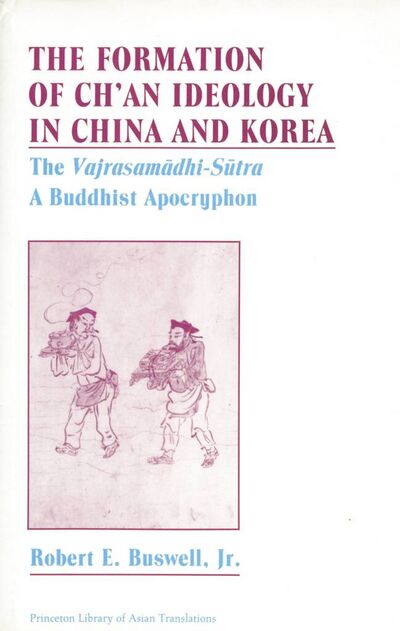The Formation of Ch'an Ideology in China and Korea
< Books
| (11 intermediate revisions by the same user not shown) | |||
| Line 12: | Line 12: | ||
'''PART ONE: STUDY''' | '''PART ONE: STUDY''' | ||
| − | *{{i|'''Chapter One''' The ''Vajrasamādhi-Sūtra'' as an Apocryphal Scripture|3}} | + | *{{i|'''Chapter One:''' The ''Vajrasamādhi-Sūtra'' as an Apocryphal Scripture|3}} |
**{{i|Problems and Prospects of Studying the ''Vajrasamādhi-Sūtra''|4}} | **{{i|Problems and Prospects of Studying the ''Vajrasamādhi-Sūtra''|4}} | ||
**{{i|The Eclecticism of the ''Vajrasamādhi''|24}} | **{{i|The Eclecticism of the ''Vajrasamādhi''|24}} | ||
| Line 18: | Line 18: | ||
**{{i|The ''Vajrasamādhi'' in the Chinese Catalogues|33}} | **{{i|The ''Vajrasamādhi'' in the Chinese Catalogues|33}} | ||
| − | *{{i|'''Chapter Two''' The Hagiographies of the Korean Scholiast Wǒnhyo: The Dating<br> and Provenance of the ''Vajrasamādhi''|41}} | + | *{{i|'''Chapter Two:''' The Hagiographies of the Korean Scholiast Wǒnhyo: The Dating<br> and Provenance of the ''Vajrasamādhi''|41}} |
**{{i|The ''Sung Kao-seng chuan'' Hagiography and the Provenance of the<br>''Vajrasamādhi''|43}} | **{{i|The ''Sung Kao-seng chuan'' Hagiography and the Provenance of the<br>''Vajrasamādhi''|43}} | ||
**{{i|The ''Samguk Yusa'' Hagiography and the Dating of the ''Vajrasamādhi''| 60}} | **{{i|The ''Samguk Yusa'' Hagiography and the Dating of the ''Vajrasamādhi''| 60}} | ||
| − | Chapter Three The Doctrinal Teachings of the | + | *{{i|'''Chapter Three:''' The Doctrinal Teachings of the ''Vajrasamādhi''|74}} |
| − | The Acculturation of Buddhism to East Asia 74 | + | **{{i|The Acculturation of Buddhism to East Asia|74}} |
| − | + | **{{i|Tathāgatagarbha and the Immanence of Enlightenment|78}} | |
| − | + | **{{i|Amalavijñāna and the Innate Purity of Mind|92}} | |
| − | The Meaning of " | + | **{{i|The Meaning of "Vajrasamādhi": The Practical Implications of Innate Enlightenment|104}} |
| − | of Innate Enlightenment 104 | + | **{{i|The ''Vajrasamādhi'''s Message to Silla Buddhists|115}} |
| − | The | ||
| − | Chapter Four Ch'an Elements in the | + | *{{i|'''Chapter Four:''' Ch'an Elements in the ''Vajrasamādhi'': Evidence for the Authorship<br> of the Sūtra|123}} |
| − | for the Authorship of the | + | **{{i|Ch'an Influences in the ''Vajrasamādhi''|123}} |
| − | Ch'an Influences in the | + | **{{i|Early Korean Sǒn and the Legend of Pǒmnang|164}} |
| − | Early Korean | + | **{{i|The Authorship Problem|170}} |
| + | **{{i|The Legacy of the ''Vajrasamādhi''|177}} | ||
| + | **{{i|The Place of the ''Vajrasamādhi'' in the Evolution of Ch'an|179}} | ||
| + | |||
| + | '''PART TWO: TRANSLATION''' | ||
| + | *{{i|The ''Vajrasamādhi-Sūtra'' (''Book of Adamantine Absorption'')|184}} | ||
| + | **{{i|Chapter One: Prologue|185}} | ||
| + | **{{i|Chapter Two: The Signless Dharma|188}} | ||
| + | **{{i|Chapter Three: The Practice of Nonproduction|196}} | ||
| + | **{{i|Chapter Four: The Inspiration of Original Enlightenment|202}} | ||
| + | **{{i|Chapter Five: Approaching the Edge of Reality|211}} | ||
| + | **{{i|Chapter Six: The Voidness of the True Nature|224}} | ||
| + | **{{i|Chapter Seven: The Tathāgatagarbha|232}} | ||
| + | **{{i|Chapter Eight: Dhāraṇī (Codes)|240}} | ||
| + | **{{i|Epilogue|249}} | ||
| + | |||
| + | **{{i|''Glossary of Chinese Logographs''|252}} | ||
| + | **{{i|''Works Cited''|265}} | ||
| + | **{{i|''Index''|293}} | ||
| + | |PublisherLogo=File:Princeton University Press logo.png | ||
| + | |StopPersonRedirects=No | ||
|AddRelatedTab=No | |AddRelatedTab=No | ||
}} | }} | ||
Latest revision as of 12:44, 22 June 2023
This book contains an extensive study and a translation of the Vajrasamādhi Sūtra and makes a convincing argument to rethink the "national lines of argument" that had previously dominated discussions of East Asian Buddhist traditions. Buswell shows how Chan developed in multiple communities; it was not a Chinese phenomenon that was then exported to Korea and Japan. He also shows how the scripture is firmly in the Chinese Yogācāra tradition of Paramārtha, containing an extensive discussion of "immaculate consciousness" (amalavijñāna), the ninth consciousness which unites saṃsāra and nirvāṇa in a "single taste." Buswell draws on Japanese scholarship, such as that by Mozuno Kōgen, who first concluded that the sūtra was an apocryphon.
| Citation | Buswell, Robert E., Jr. The Formation of Ch'an Ideology in China and Korea: The Vajrasamādhi-Sūtra, A Buddhist Apocryphon. Princeton Library of Asian Translations. Princeton, NJ: Princeton University Press, 1989. |
|---|---|


